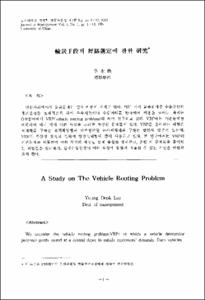박용 AH36 Grade TMCP 강의 일렉트로가스 용접부의 피로균열 특성에 관한 연구
- Alternative Title
- A Study on the Fatigue Crack Growth Behavior of AH36 grade TMCP Steel Weldment
- Abstract
- 박용 고장력강(AH36 grade TMCPsteel)의 엘렉트로가스 용접부의 피로균열 성장속도와 파괴거동 평가를 위해 본 연구를 수행하였으며 재료의 압연방향과 그 직각방향을 비교하?눼?. 또한 용접 잔류응력과 2차 균열이 피로균열 성장속도를 감소시키는 영향을 나타냄을 알게되었다. 모재의 경우가 용접부나 열영향부 보다도 피로균열 성장 속도가 더 크게 나타남을 관찰할 수 있었다. 피로균열 성장속도에 대한 시험치와 스트라이에이션 간격(Striation Spacing)에 대한 실험식의 값을 비교한 결과 낮은 응력확대계수 범위에서는 유사한 경향을 나타내었다.
The experimental study has been carried out in order to estimate the fatigue crack growth behavior of AH36 grade TMCP steel applied with electrogas welding process and the effect of rolling direction on the fatigue crack growth was investigated. The results of this study can be summarized as follows :
1) Fatigue crack growth rate of the base metal is higher than that of the weld metal and the heat affected zone.
2) The experimental values of fatigue crack growth rate has a close relationship with the striation spacing in low stress intensity range.
3) Secondary cracks are observed on the fatigue fracture surface of all specimens and resulted in the reduction of the fatigue crack growth rate.
4) The difference between the fatigue crack growth rates of the base metal and weldment is considered due to the compressive residual stress and the secondary crack.
The experimental study has been carried out in order to estimate the fatigue crack growth behavior of AH36 grade TMCP steel applied with electrogas welding process and the effect of rolling direction on the fatigue crack growth was investigated. The results of this study can be summarized as follows :
1) Fatigue crack growth rate of the base metal is higher than that of the weld metal and the heat affected zone.
2) The experimental values of fatigue crack growth rate has a close relationship with the striation spacing in low stress intensity range.
3) Secondary cracks are observed on the fatigue fracture surface of all specimens and resulted in the reduction of the fatigue crack growth rate.
4) The difference between the fatigue crack growth rates of the base metal and weldment is considered due to the compressive residual stress and the secondary crack.
- Issued Date
- 1997
- Type
- Research Laboratory
- Alternative Author(s)
- Ham,won-kuk
- Publisher
- 공학연구논문집
- Language
- kor
- Rights
- 울산대학교 저작물은 저작권에 의해 보호받습니다.
- Citation Volume
- 28
- Citation Number
- 1
- Citation Start Page
- 345
- Citation End Page
- 366
- Appears in Collections:
- Research Laboratory > Engineering Research
- 파일 목록
-
-
Download
 000002024346.pdf
기타 데이터 / 430.92 kB / Adobe PDF
000002024346.pdf
기타 데이터 / 430.92 kB / Adobe PDF
-
Items in Repository are protected by copyright, with all rights reserved, unless otherwise indicated.